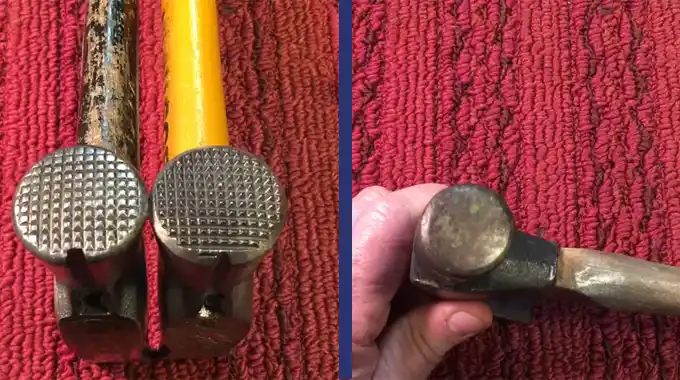Last Updated on January 26, 2023
When it comes to hammers, there are two common types of faces: milled and smooth. So, what’s the difference? Milled faces have a textured surface that helps to grip the nail better, while smooth faces are just that smooth.
Milled face vs smooth face hammer which type of face you choose is ultimately up to preference, but there are some advantages and disadvantages to both. Milled faces provide more grip, making it less likely for the nail to slip. However, they can also leave marks on the wood.
Smooth faces have a sleek finish and are less likely to mar the wood, but they don’t provide as much grip. Ultimately, it’s up to you to decide which type of face is best for your needs.
Milled Face vs Smooth Face Hammers: What’s the Difference?
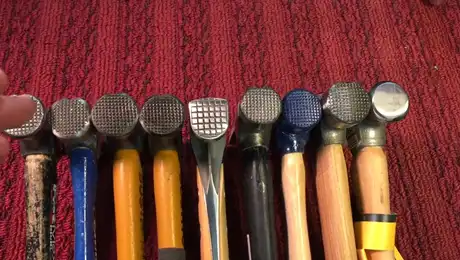
If you know the difference between a milled face and a smooth face hammer, it’s easy to select the right tool for the job. Here are some of the key differences:
Size:
Milled face hammers are available in different sizes, but they tend to be larger than smooth face hammers. Smooth face hammers also are typically smaller than milled face hammers.
If you want to use a small hammer for delicate work, then a smooth face hammer is a better choice. When you need a larger hammer, we recommend framing hammers with a milled face. Since most people prefer a small hammer for everyday tasks, the smooth face hammer is more common.
Winner: Smooth face hammer
Weight:
Milled face hammers are usually heavier than smooth face hammers. This is because the milled face adds weight to the hammer head. A lighter hammer is easy to handle and suitable for many tasks.
Winner: Smooth face hammer
Grip:
Smooth Face Hammers have, as the name implies, a smooth striking face. However, the smooth surface can make the head more slippery, making it more likely to slip.
Milled Face hammers have a milled (textured) face which provides a more secure grip on nails and prevents them from slipping and marrying the workpiece. As a result, Milled Face hammers are less likely to “bounce” off the workpiece, reducing the risk of injury to the user.
The winner: Milled Face Hammer
Driving Nails:
A Smooth Face Hammer is better for driving nails into wood, as there is less risk of the head slipping and injuring the user. The smooth surface also helps to prevent damage to the workpiece.
A Milled Face Hammer can also be used for driving galvanized nails, but the raised surface can make it more difficult to control. In addition, the milled face is more likely to slip and cause injury.
Winner: Smooth face hammer
Durability:
Milled face hammers tend to be more durable than smooth face hammers because the textured surface helps to protect the head from impact. When the head of a hammer hits a hard surface, such as a nail or piece of wood, the shock is absorbed by the milling. This reduces the risk of cracking or chipping.
Smooth face hammers are also quite durable, but they are more likely to suffer from wear and tear over time. The slick surface can make it easy for nails to slip, which can lead to misshaping. Additionally, the smooth surface is more susceptible to scratches and dents, which can reduce its lifespan.
The winner: Milled Face Hammer
Possibility of Damaging to the surface:
A Smooth Face Hammer is less likely to cause damage to the surface you are hitting. On the other hand, because Milled Face hammers have a more textured surface, they are more likely to leave marks on the surface.
Winner: Smooth Face Hammer
Cost:
Milled face hammers are generally more expensive than smooth face hammers. This is because they use better materials and last longer. If you want a durable hammer that will last for years, then a milled face hammer is a good choice.
Winner: Smooth face hammer
As you can see, there are several key comparisons among milled face and smooth face hammers. When choosing the best hammer for your next project, consider the size, weight, grip, and durability.
Milled Face Vs. Smooth Face Hammers: Which is Better for You?

Now that you know the uses and distinctions between hammers with milled faces and smooth faces, you can decide which type is best for your next project. Overall, the best hammer for most people is a smooth face hammer. These hammers are lighter, easier to handle, and less damaging.
However, if you need a more durable hammer for a tougher job, then a milled face hammer may be the best option. These hammers are usually made of higher-quality materials and have a longer lifespan.
How to Use a Milled Face Hammer?

A milled face hammer has a textured surface on the head of the hammer, which helps to grip the nail and prevent it from slipping. To work with a milled face hammer, Follow the instructions:
Step 1. Start by holding the hammer in your dominant hand and positioning the nail near the edge of the board.
Step 2. Then, align the hammer head with the top of the nail and strike the nail with a quick, firm motion. As you drive the nail into the board, continue to hold the head at an angle so that it doesn’t slip off.
Step 3. When you reach the desired depth, remove the nail by gently rocking it back and forth until it comes loose.
How to Use a Smooth Face Hammer?
While it may seem like a simple tool, there is a bit of technique involved in using a smooth face hammer effectively. Here is a step-by-step guide to using a smooth face hammer:
Step 1: Position the hammerhead so that it is perpendicular to the object you are striking. This will give you the most control and accuracy.
Step 2: Grip the handle firmly with your dominant hand. Your other hand should be placed underneath the head of the hammer for support.
Step 3: Swing the hammer in an arc, striking the object squarely in the center. Use as much force as necessary to complete the task at hand.
Other Parts of a Milled or Smooth Face Hammer
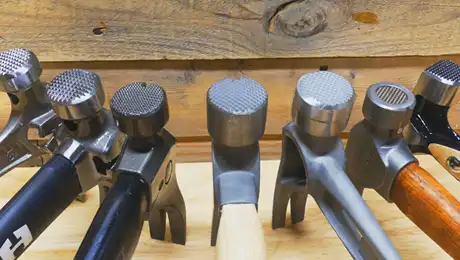
Listed below are other components of a milled and smooth face hammer.
Handle Material:
Both milled face and smooth face hammers have handles that are typically made of titanium, graphite, hickory, or steel.
Titanium:
A titanium hammer is a special DIY tool. This stiletto tool is made up of a titanium alloy that is strong and lightweight. They are widely known for their durability, as they can withstand a lot of wear and tear.
They are also resistant to corrosion, making them ideal for use in environments with moisture or chemicals present. Titanium hammers are available in a variety of sizes and shapes, depending on the specific application.
For example, some titanium hammers have a flat head while others have a pointed head. The weight of these hammer depends on the size and shape of the tool.
Graphite:
The head of the graphite hammer consists of steel, and the handle is made of graphite. It has shock and vibration reduction properties. This makes the graphite hammer ideal when there are a lot of impacts.
The graphite hammer resists corrosion and is resistant to chemicals. It is also non-conductive, making it safe to use around electrical equipment.
Hickory:
A hickory handle of a Hammer is used to remove Hickory nuts from their shells. It has a long handle with a claw on end. Hickory nuts are very hard to remove from their shells without the Hickory Hammer. The claw is used to puncture the shell of the Hickory nut and then pull the nut out of the shell.
Steel:
Hammers made of steel are widely used throughout the world. Steel is an alloy of iron and carbon, which makes it much harder than iron alone. This makes it ideal for use in applications where a soft metal would not be strong enough, such as construction or automotive work.
They are also less likely to break than those made from other materials, making them a favorite among tradesmen and hobbyists alike. In addition, a steel hammer is also easy to find and relatively affordable, making it a great choice for anyone in need of a reliable tool.
Fiberglass:
Fiberglass hammers are made with a fiberglass shaft and a steel head. They are designed for use in applications where there is a lot of vibration, such as construction work.
Fiberglass is a strong material that is resistant to breaking and shattering. The fiberglass hammer absorbs vibrations, making it easier on the user’s hands and arms.
Head Material:
The head of a hammer is the part that does the work. It is usually made of steel or titanium. The head is attached to the handle with a steel collar, and it is held in place with a steel pin. Its head is also wider than the handle, which facilitates an even distribution of the blow’s force.
Claw:
The framing hammer comes with Flatter/straight claw. With a straight claw hammer, you will have more control over the nails. And, it is easy to remove the nails with this type of hammer.
On the other hand, a finish hammer has a curved claw. The curved claw or nail puller helps to pull the nails out of the wood easily.
Side Pryer:
On the side of most hammers, there is a V-shaped prying edge known as a side pryer. This feature is useful for a variety of tasks, such as pulling nails, prizing open stubborn doors and windows, and levering up floorboards.
The V-shape of the pryer allows you to apply greater force to the object you are trying to move, as well as giving you more control over the direction of the force.
Magnetic Nail Holder:
Some hammers come with a magnetic nail set built into the head. This is a small metal plate that holds nails in place while you are hammering them. It is particularly useful for starting nails in tight spaces or at awkward angles.
Anti-Shock Handle:
An anti-shock handle is a feature that is designed to reduce the amount of shock and vibration that is transferred to your hand when the hammer strikes an object. This can be particularly useful if you are working with materials that are prone to shattering, such as glass or ceramic.
Anti-Ring Claw:
The anti-ring claw reduces the noise that is produced by striking an object with the hammer. This can be useful if you are working in an environment where noise levels need to be kept to a minimum, such as a hospital or an office.
What is a Milled Face Hammer?
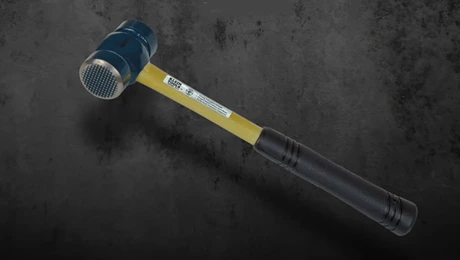
A milled face hammer is a tool that is used to pound nails into wood. It is also known as waffle face or checkered face hammer. The textured side is known as the “milled face”. A framing hammer is usually made with a milled face.
These hammer heads are made of metal. Its head has a smooth, flat surface on one side and a raised, textured surface on the other side.
When pounding a nail into wood, the milled face prevents it from slipping. This type of hammer is useful for hardened objects.
Common Uses of Milled Face Hammer
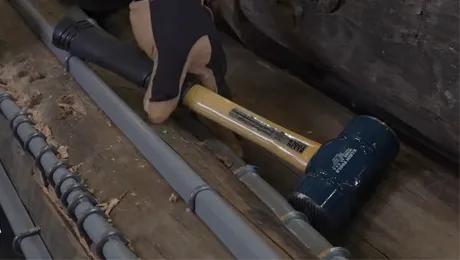
Milled face or framing hammers are one of the most versatile hand tools that a worker can have in their toolkit. Though their primary use is driving nails, they can also perform other tasks, such as:
Framing Wall Systems:
A milled face hammer plays a crucial role when it comes to framing wall systems. It can be used to attach boards together and even rip boards apart.
Concrete Forms:
If you’re working with concrete forms, a milled face hammer can be used to help create the perfect shape. By using the textured side of the hammer, you can create dimples in the concrete that will help hold it in place.
Joists and Trusses:
These types of framing hammers are also useful for attaching joists and trusses. The smooth side of the hammer can be used to hit nails flush with the surface.
Rafters:
When working with rafters, a milled face hammer will work to hold the wood in place while the nails are being driven in. This hammer is a vital tool for any carpenter who wants to create rafters that are both strong and beautiful. With its help, it is possible to create rafters that will last for generations.
Ripping Boards Apart:
Splitting and opening boards is a breeze with these specialty tools. Once you have the board split, use a pry bar to remove any nails that are still holding it together. For extra leverage, you can use a pry bar with a claw on one end. This will make it easier to remove nails without damaging the wood.
What is a Smooth Face Hammer?
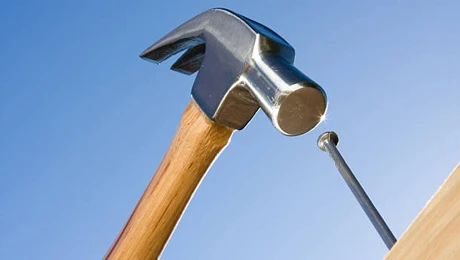
The head of the hammer is smooth, without any ridges or protrusions, and the handle is usually made of metal. A claw hammer or finish hammer has a smooth face. The flat side of the head is used to drive nails into hardwood, while the claw can be used to remove nails.
A small hammer might be used for delicate work, while a larger hammer would be better suited for heavier-duty tasks. In addition to their size, smooth face hammers also vary in weight, with some models being much lighter than others. This allows users to select a hammer that best suits their needs.
Common Uses of a Smooth Face Hammer
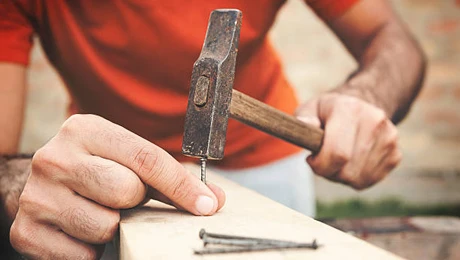
The smooth face hammer is also known as a finish hammer. It can be used for a wide range of tasks, from trimming lumber to driving finish nails.
Trimming:
You can use a smooth face hammer to trim excess lumber from your project. Simply hold the piece of wood in place and use the hammer to chisel away any unwanted pieces.
Drywall Nailing:
One of the most common uses for a smooth face hammer is drywall nailing. When hung correctly, drywall provides a clean, finished look to any wall. To ensure that the drywall is properly hung, smooth face hammers are used to drive nails into the studs.
Masonry Work:
Smooth face hammers can also be used for masonry work. When laying brick or stone, it is important to use a hammer with a smooth face so that you do not damage the material.
Flooring Tiles:
The hammer face with a smooth shape is also useful for setting flooring tiles. By gently tapping the tile into place with a smooth face hammer, you can create a professional-looking finish without chipping or cracking the tile. As you can see, the smooth face hammer is an essential tool for any home improvement project.
FAQs:
Q: What Hammer do Most Carpenters Use?
A claw hammer is the most popular type of hammer among carpenters. It serves a dual purpose. It is capable of driving nails into wood and also to pry nails out of wood. The claw hammer has a long history, dating back to the days of blacksmiths who would fashion them by hand.
Q: Are Heavier Hammers Better?
A heavier hammer will deliver a harder strike, making it better for driving nails or breaking up concrete. And while a lighter hammer may be easier to swing, it simply can’t match the power of a heavier one. So if you’re looking for a hammer that can get the job done, go for the heaviest one you can handle.
Q: Are Titanium Hammers Worth it?
Titanium hammers are popular among construction workers and DIY enthusiasts for their durability and vibration-dampening properties. Unlike steel hammers, which can transfer vibrations to the arm and cause pain or numbness, titanium hammers have a softer face that absorbs shock and reduces kickback.
Q: What Kind of Hammer Do Electricians Use?
Straight-Claw Hammer: The Straight-Claw Hammer is the most common type of hammer used by electricians. It has a fiberglass shaft that is comfortable to hold and a head that is made of drop-forged steel. The Straight-Claw Hammer also has a pointed end that can be used to pry nails out of electrical boxes.
Conclusion:
Hammers are very useful hand tools that come in a variety of shapes, sizes, and weights. The type of hammer you choose will depend on the task at hand.
When it comes to milled face vs smooth face hammer, you have to consider the weight and the size of the head, and where to use it. If you need a powerful tool, go for the milled face hammer, as it delivers a harder strike. If you need a lighter and more versatile tool, the smooth face hammer is the best choice.
Our guide has hopefully given you a better understanding of the differences between milled face and smooth face hammers to make an informed decision about which one is right for you.
